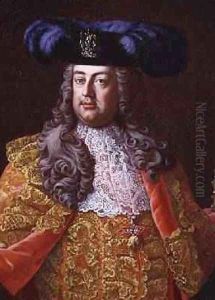Martin I Mytens Paintings
Martin I Mytens, also known as Martin van Mytens the Elder, was a Dutch-Swedish painter born in The Hague in 1648. Mytens hailed from a family of artists, which laid the groundwork for his eventual career in the arts. His early education and artistic training were rooted in the Dutch Golden Age of painting, a period renowned for its emphasis on realism, attention to detail, and the exploration of light and shadow. These foundational elements would become hallmarks of Mytens's own work as he developed his style and expertise. In search of new opportunities and commissions, Mytens moved to Sweden, where he would spend the majority of his career and life, ultimately becoming a significant figure in the Swedish art scene.
In Sweden, Mytens established himself as a court painter, a prestigious position that allowed him to work closely with the Swedish royal family and the aristocracy. His ability to capture the likeness and character of his subjects with elegance and accuracy made him a favored artist among the elite. Mytens's portraits are particularly noted for their sophisticated use of color, refined compositions, and the skilled depiction of fabrics and textures, which lent a sense of grandeur and dignity to his subjects. Through his portraits, Mytens played a crucial role in shaping the visual representation of the Swedish nobility during the 17th and early 18th centuries.
Beyond portraiture, Mytens's oeuvre includes religious and mythological scenes, though these works are less well-known and less numerous. His success and influence in Sweden were marked not only by his own achievements but also by the legacy he left through his students and descendants, some of whom continued the family tradition of painting. Martin I Mytens's career reflects the broader cultural exchanges between the Netherlands and Sweden during his lifetime, embodying the movement of ideas, styles, and artistic practices across Europe. He passed away in Stockholm in 1736, leaving behind a body of work that continues to be appreciated for its contribution to the European art of the 17th and early 18th centuries.
